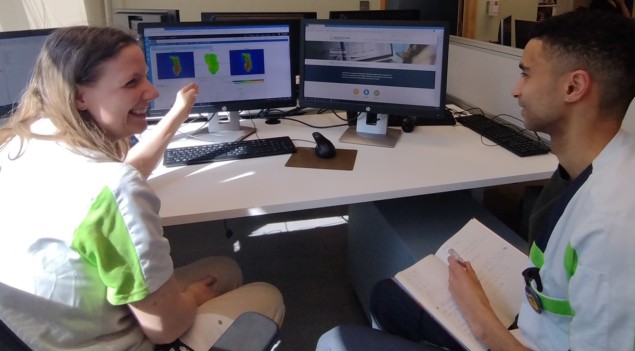The SunCHECK Quality Management Platform is helping medical physicists to optimize the radiotherapy workflow by automating the analysis of large-scale clinical data sets

Electronic portal imaging devices (EPIDs) are now widely used as dosimeters by radiation oncology clinics – both for automated pre-treatment verification (without the patient present) and for transit in vivo dosimetry (with the patient in situ on the treatment couch). In the case of the latter, the motivation is to enhance patient safety by detecting errors and deviations in dose delivery (owing to changes in patient anatomy, for example) over the course of radiation treatment, while simultaneously addressing the increased patient QA complexity of advanced modalities such as volumetric modulated arc therapy (VMAT) and stereotactic body radiotherapy (SBRT).
Beyond the immediate upsides of transit in vivo dosimetry – chiefly, a final safety net for the healthcare team and the patient – there’s also the longer-term roadmap towards at-scale patient-specific quality assurance (PSQA). Put another way: fully automated, EPID-based transit dosimetry opens the way for medical physicists to not only detect divergence of an individual radiotherapy fraction versus the treatment plan, but to use the cumulative (and ever-growing) patient QA data set as a tool to re-evaluate and reimagine best practice within the radiation oncology workflow.
The engine-room of patient QA
A pioneer in this regard is Dirk Verellen, director of medical physics at Iridium Netwerk, a multi-site radiation oncology programme in the Greater Antwerp region of Belgium. Earlier this year, Verellen and his team published a granular analysis of a four-year PSQA data set spanning a large cohort of Iridium Netwerk cancer patients with diverse disease indications. Their findings are instructive, demonstrating systematic correlation between transit dosimetry measurements over time versus adaptations within the clinical workflow. “Our results suggest EPID in vivo dosimetry is able to assess the impact of some adaptations to the workflow and can therefore assist in continuous quality improvement of patient treatment and outcomes,” explains Verellen.

At the heart of Iridium Netwerk’s PSQA work programme is the SunCHECK Quality Management Platform from Sun Nuclear (a Mirion Medical company), the US-based manufacturer of independent QA solutions for radiotherapy facilities and diagnostic imaging providers. Deployed across the Antwerp healthcare system’s four treatment centres through late 2017 and early 2018, SunCHECK comprises a single interface and database offering a unified view of patient and machine QA that’s independent from the treatment system. As such, SunCHECK’s two core software modules – SunCHECK Patient and SunCHECK Machine – are now established as the QA “engine-room” for Iridium Netwerk’s distributed medical physics service.
That service, staffed by 19 medical physicists and seven physics assistants, is built around a unified suite of Varian treatment systems (currently nine TrueBeam machines and one Clinac iX) delivering leading-edge cancer care to around 6000 patients every year. Two treatment planning systems (TPS) deal with the heavy lifting in advance of treatment delivery: RayStation (from RaySearch Laboratories, Sweden) for stereotactic plans and Varian’s Eclipse TPS for all other types of treatment plan. Meanwhile, SunCHECK Patient encompasses all aspects of Iridium Netwerk’s patient QA, including secondary checks, phantomless pre-treatment QA and automated in vivo monitoring (with the EPID-based measurements managed by SunCHECK’s dedicated PerFRACTION software module).
“With PerFRACTION, we’ve shown that large-scale clinical implementation of in vivo transit dosimetry is feasible, even for complex techniques,” says Evy Bossuyt, a senior medical physicist in Verellen’s team and project lead for the integration and ongoing development of SunCHECK Patient within the Iridium Netwerk radiotherapy programme. “In this way, PerFRACTION adds an extra dimension to patient QA, revealing a variety of deviations spanning errors in planning, machine problems, patient positioning and changes in patient anatomy such as weight loss, tumour shrinkage or rectal/bladder filling.”
Alongside the enhanced error detection, the Iridium Netwerk medical physics department has seen significant streamlining over the past five years with regards to the aggregate workload and staff-time allocated to essential patient QA checks. “That’s down to SunCHECK Patient’s high degree of automation plus the in-built accessibility that comes from a web-based software platform,” notes Bossuyt.
Data-driven insights
That emphasis on automation and online access is, by extension, fundamental to Iridium Netwerk’s retrospective PSQA study – a longitudinal review that aggregates data from all the group’s radiotherapy patients treated between September 2018 and August 2022. In total, Bossuyt and colleagues analysed 84,100 transit in vivo dosimetry measurements, dividing them into four yearly periods. The team also classified failed measurements by pathology and into four categories of failure: technical, planning and positioning problems as well as anatomical changes in the patient.
“We investigated if the observed trends in the in vivo dosimetry results versus time could be a result of adaptations to the clinical workflow,” explains Bossuyt. “Also the other way around: if the impact of adaptations could be monitored via the in vivo dosimetry.”

Iridium Netwerk’s medical physics team redefines best practice in radiotherapy QA
Overall, Bossuyt and the project team found that the number of failed measurements linked to patient-related problems gradually decreased from 9.5% to 5.6% over the four-year study period (see “Further reading”). What’s more, a deep-dive into the transit dosimetry data set reveals no shortage of success stories reflecting the impact of targeted workflow changes.
Failed measurements attributed to positioning problems, for example, decreased from 10.0% to 4.9% in boost breast-cancer patients after the introduction of extra imaging; from 9.1% to 3.9% in head-and-neck patients following education of radiation therapists on positioning of patients’ shoulders; from 6.1% to 2.8% in breast-cancer patients after introduction of ultrahypofractionated breast radiotherapy with daily online pre-treatment imaging; and from 11.2% to 4.3% in extremities following introduction of immobilization with calculated couch parameters and a surface-guided radiation therapy solution. Elsewhere, following targeted patient education from dieticians, failed measurements related to anatomical changes decreased from 10.2% to 4.0% in colorectal patients and from 6.7% to 3.3% in prostate patients.
Automate and accumulate
Verellen and Bossuyt, for their part, are already thinking about next steps regarding the clinical exploitation of PerFRACTION and transit dosimetry. One use-case under investigation is the automatic triggering of offline (ultimately online) adaptation for specific disease indications – in head-and-neck patients, for example, where the anatomy adjacent to the tumour often changes only slowly during the course of treatment.
“We’re evaluating a workflow that’s able to ‘red-flag’ significant changes in patient anatomy based on transit dose measurements over the previous three or four fractions,” says Verellen. “Automation is the key to success here,” he adds. “Using the transit dose data to show that the treatment plan is gradually decreasing in quality, the organs-at-risk are reaching their safe limits, so it might be time to replan the patient. That’s where we want to go next with our patient QA platform.”
As a SunCHECK reference site, Iridium Netwerk promotes radiotherapy QA best practice using the SunCHECK Quality Management Platform. The clinical team collaborates with Sun Nuclear on its product development roadmap while serving as a regional resource for the growing European base of SunCHECK users.
Further reading
Evy Bossuyt et al. 2023 Assessing the impact of adaptations to the clinical workflow in radiotherapy using transit in vivo dosimetry (phiRO 25 100420)
- For more information about SunCHECK, visit Sun Nuclear on booth 150 at the ESTRO Annual Congress in Vienna, Austria (12–15 May).




